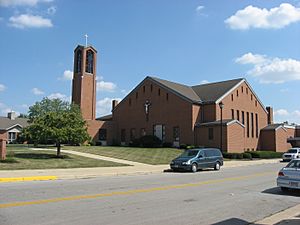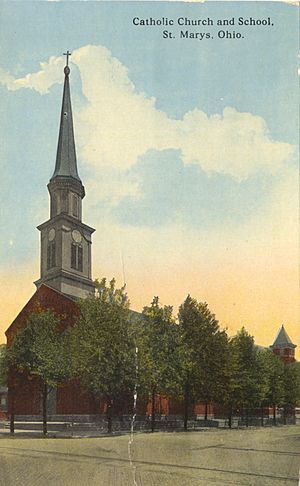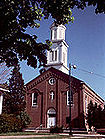Holy Rosary Catholic Church (St. Marys, Ohio) facts for kids
Quick facts for kids Holy Rosary Catholic Church |
|
|---|---|

Front of the present Holy Rosary Church
|
|
| 40°32′42″N 84°22′58″W / 40.54500°N 84.38278°W | |
| Location | Junction of E. Spring and S. Pine Sts. in St. Marys, Ohio |
| Country | United States |
| Denomination | Roman Catholic |
| Website | www.holyrosarychurch.us |
| History | |
| Founded | 1852 |
| Administration | |
| Deanery | St. Marys Deanery |
| Archdiocese | Archdiocese of Cincinnati |
Holy Rosary Catholic Church is a Roman Catholic church located in St. Marys, Ohio. It was started in 1852. The church is known for its original building from the 1860s. This historic building was taken down in the 1970s because the church community was growing. A new, more modern building was then built in its place.
Contents
How the Church Started
The first Catholic families came to St. Marys in 1831. Many more Catholics moved to the area in the 1840s. This happened because the Miami and Erie Canal and Grand Lake St. Marys were being built. A lot of German Catholics settled in western Ohio, near St. Marys.
Priests from the Society of the Precious Blood settled in Minster. Minster is about 10 miles south of St. Marys. For 20 years, Catholics in St. Marys often traveled to Minster for Mass. This changed when Holy Rosary parish was officially started in 1852. In its early days, the church was also connected with St. Thomas parish. This other church was in Six Mile, about 5 miles northeast.
Growing the Community
By 1854, the church members built their first church. It was made of logs. The church also bought more land in 1861 for a cemetery and a small rectory (a house for the priest).
However, the number of church members grew quickly. The log church became too small for everyone. The community was not rich enough to build a new, bigger church yet. Joseph Gregory Dwenger, a leader in the church, encouraged the parish. The Archbishop of Cincinnati, John Baptist Purcell, also helped. Other churches in the Archdiocese of Cincinnati gave a lot of money.
The parish finished its new church in 1867. It cost $12,000, which was a lot of money back then. The church was designed by Anton Goehr, an architect from Minster. It was a simple brick building with a bell tower. It had a strong stone foundation. The original log church was moved to the canal banks in downtown St. Marys.
As the church continued to grow into the 1880s, a bell was added to the steeple. A new rectory was also built for almost $3,000. Interestingly, people who were not Catholic helped pay for almost half of the rectory's cost. As the church members became wealthier, and because of some anti-Catholic feelings in the area, a parish school was started in 1902.
New Buildings for a Growing Church
By the 1940s, the church building needed a lot of repairs. It was getting old. In the 1950s, more and more students joined the school. The old school building became too crowded. A brand new school was built in its place. It was ready for students by the 1957 school year.
By the late 1960s, the church that was built in 1867 was also too small. The number of people attending services had grown too much. Plans to build a new church began in 1969. Surveys showed that almost three out of four church members wanted a new building. So, the original 1867 church was taken down in 1978. Its replacement was finished the next year, in 1979. Some parts of the old church were saved. For example, its organ and some of its windows were used in the new building.
Historic Recognition
Even though the 1867 church was torn down, it was still recognized for its history. One year after it was demolished, in 1979, the church was listed on the National Register of Historic Places. This is a list of places important to American history. It was listed for its special architecture. Many other Catholic churches in western Ohio, known as the "Land of the Cross-Tipped Churches," were also listed. Even though the second building was taken down many years ago, it is still on the National Register today.
Since the mid-1800s, the Catholic Church has been a very important part of life in this area of Ohio. Many large Gothic Revival churches were built in small farming towns. When Holy Rosary Church was first suggested for the National Register in 1977, it was seen as one of the most important Catholic churches built in the area during the mid-1800s.
Eight churches in the region were built during this time. They were simple brick buildings with small bell towers. Only Holy Rosary and Holy Family Church in Frenchtown kept their original look. The other six churches added tall spires later. Not many churches built before this time are still standing. Only St. John's Catholic Church in Fryburg has not changed much. Holy Rosary's very first log building, which is now a house by the canal, is one of the few that still exist in any form.
Holy Rosary is still an active church today. It is part of the Archdiocese of Cincinnati. It works closely with St. Patrick parish in Glynwood. Both churches are part of the St. Marys Deanery.






